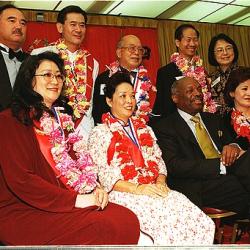Mindy Kaling’s comedy Never Have I Ever returned to Netflix for a third season earlier this month, and as with the first two seasons, there’s much to discuss about how the show portrays Asian Americans, religion, and race.
In a follow-up to the roundtables organized for Season One and Season Two, I brought together five scholars to reflect on different aspects of the newest season of NHIE: Dr. Shalini Shankar considered themes of class and caste, Dr. Swapnil Rai discussed the irreverent portrayal of Indian American religious life, Dr. Himanee Gupta examined the show’s portrayal of the model minority myth, Dr. Rupa Pillai addressed the possibilities of the American Dream, and I connected the show’s depiction of Navratri with broader patterns in Asian American religion and home life.
Please note: we include a couple spoilers here, so you might want to watch Season Three in full before proceeding with this roundtable!
Class, Caste, and Diaspora
Dr. Shalini Shankar
Professor of Anthropology and Asian American Studies, Northwestern University
Caste is an engrained system of inequality that has survived centuries in South Asia. High caste individuals who have long had the greatest access to education are also the ones who immigrated as skilled professionals, addressing the U.S. call for STEM workers in both 1965 and 1990. In NHIE, Devi Vishwakumar’s family is presumably part of the latter cohort, and based on language use in the show, part of an Indian elite colloquially known as Tamil Brahmins or “Tam Brams.”
NHIE has consistently signaled its commitment to upper caste status in Seasons 1 and 2. In earlier episodes, Kamala breaks up with her non-Indian boyfriend and begins to take the process of meeting suitable boys seriously. The women—Nalini, Kamala, Devi, and eventually Pati—publicly celebrate major holidays like Ganesh puja in ways only available to upper caste Hindus. Nalini, having lost her beloved husband Mohan in flashback, continues to prominently wear her wedding tali or wedding necklace, one that distinctively marks her as Tam Bram.
In Season 3, Episode 2, when Pati’s disappointment about Kamala’s broken engagement becomes untenable, her only way of moving forward is to find her granddaughter a new fiancée. Her clique from the temple dress up their nerdy Tam Bram sons to compete for Kamala’s attention but their efforts are foiled when Devi’s teacher Manish crashes the party.
Manish does not perform caste, class, or diasporic status like Devi’s family or the temple boys. He cannot answer Pati’s questions about his grandparents and instead casually tells her how his divorced parents violated numerous social taboos, including running a night club and marrying a white person.
While his unsavory background promises he does not come from money, his public school teacher’s salary suggests a frugal life with minimal economic mobility. Zeroing in on this lack of status, Pati is unequivocal in her disapproval of Manish, dramatically avowing that she cannot show her face in temple if Kamala were to date him. When Pati eventually softens to Manish due to his kindness toward Devi during one of her many teenage blunders, she still openly calls him weak and in need of protection, rendering him the opposite of a powerful high caste man.
Even with arranged marriage being glamorously reinvigorated in trendy reality shows like Netflix’s Indian Matchmaking, scenes like this remind us that the underlying goal is to maintain caste and class endogamy. NHIE has many options in representing caste and class in diaspora, but thus far has taken a highly predictable, normative path, one that aligns with conservative Hindu right values. A show that is otherwise invested in progressive politics of gender and sexuality would do well to consider the negative implications of reinforcing high caste values and instead use this platform to altogether reject this system of violence.
https://www.youtube.com/watch?v=d_N99x0gAAk
Religion and Irreverence
Dr. Swapnil Rai
Assistant Professor of Film, Television, and Media, University of Michigan
Season Three of NHIE features one of my favorite Indian festivals, Navratri. As a North Indian, I have always celebrated Navratri with a sense of austere devotion. Devotees are expected to fast for nine days, each day worshiping a quality of the divine feminine that the daily incarnation of the goddess symbolizes. The tenth day, Durga Puja or Vijaya Dashmi, is when your inner demons are symbolically discarded when the demon King Mahishasura, who has the ability to multiply, is finally killed by the Goddess Durga, Adi shakti, in whom all the qualities of the divine feminine coalesce.
Kaling’s depiction of Navratri gives a quick nod to this festival tradition in the scene where Fabiola, seemingly pretty impressed with the inherent discourse on feminine power in Navratri, knows what the festival is about better than Devi.
Next, we get to take a closer look at the Vishwakumar household and how they celebrate Navratri, which is very different. Golu is a doll display that includes scenes from the Mahabharata and Ramayana and statues of goddesses. It anchors the sociality around the nine-day festival when neighbors go to each others’ Golus (god/goddess doll displays) and have prasad. The South Indian take on the festival appeared more celebratory and very different from the North Indian festival when I first came across Golus in Austin, Texas. There was also a competitive element that I could sense in my Golu-displaying neighbors. Whose Golu is better than mine?
Kaling captures these slippages between divine devotion and consumerist/capitalistic fantasies in the figure of the grandmother, Pati. Her irreverent take blends the grandiose spiritual tradition of a Golu with pop iconography very specific to the Indian American community. Thus, CNN’s chief medical correspondent Sanjay Gupta’s doll makes an appearance on Pati’s Golu. Pati also includes Bloomingdale’s gift bags as favors for her competitive temple clique friend, who eventually falls on the Golu display and breaks the dolls. The chaotic irreverence on display shows the commoditized reconfigurations of traditions and rituals in an Indian American context, wherein a Golu, supposedly an austere display of the divine, becomes a way of signifying class status.
What Others Think
Dr. Himanee Gupta
Professor, SUNY Empire State College
In NHIE’s Season Two finale, Devi and Paxton make their relationship public. Season Three opens with Devi ecstatic by the rise in her status. Then, she hears gossip depicting her as a loser who must be “putting out” if Paxton is wasting time on her.
Devi’s cousin Kamala ends Season Two by walking out of a dinner party just as her model minority boyfriend Prashant was to propose marriage. She opens Season Three dating Manish, a teacher who is Indian but not tuned into Indian culture.
Kamala expresses shame and is shamed for her behavior. Paxton breaks up with Devi because she is “complicated”; in other words, she is too obsessed with how their relationship looks to others. When new flame Des – a younger Prashant – appears, all parents involved smile approvingly.
These scenes reveal how caste and the model minority myth intersect to set norms for Indian behavior. The norms are based not on ethical standards but on what others think – particularly, gossiping aunties.
Nirmala – grandmother of Devi – illustrates this best. She chastises Kamala because she fears repercussions to Kamala as well as herself. How will she face her “temple clique”?
For Devi, a telling moment comes when Des’s mother Rhyah finds Devi sobbing due to a memory of her father’s fatal heart attack. Rhyah tells Des not to get involved with Devi; the risk to his future is too great. Des obeys. There are no feelings at stake, only fears of what others will think.
Using film to unpack caste is challenging because its cues are not widely known. But here the model minority myth does the work, allowing us to see via familiar tropes how caste remains insidious, even while hidden to most.
The Centrality of Home in Asian American Religion Life
Dr. Melissa Borja
Assistant Professor of American Culture, University of Michigan
When people talk about religion, they often tend to focus on activities centered on churches, temples, congregations, and denominations. But as I discussed in a previous post, religious studies scholars have urged us to look beyond formal religious institutions and study how religious life thrives in many more places, from gyms and college campuses to activist organizations and American Girl stores.
There are many reasons why it’s essential to study religion at sites other than formal religious institutions, and it’s especially important when studying Asian Americans. For one, many Asian Americans are immigrants, and it takes time for Asian American religious groups to marshal the resources necessary to build a temple or a church. Focusing on congregations privileges wealthier and more established communities and can set us up to underappreciate groups that are smaller, newer, and less financial advantaged. Second, many Asian Americans are not Christian but practitioners of religious traditions where ritual life is centered on the home. For example, a study by the Pew Research Center found that among Asian American Buddhists, only 12 percent report attending weekly religious services, while 57 percent maintain a shrine in their home. Similarly, among Asian American Hindus, 19 percent report attending weekly religious services, while 78 percent maintain a shrine in their home. Ultimately, if we focus only on what happens in churches and temples, we miss out on understanding the vibrancy of Asian American religious life.
We see the importance of home-based ritual practices in NHIE this season in Episode Four, when Devi’s family celebrates Navratri, a significant festival celebrated by Hindus in India and in the diaspora. Unlike in Season One, when Devi’s family celebrates Ganesh Puja at an event planned by the local Hindu association and held at the local high school, the observance of Navratri takes place at Devi’s house. Devi, her family, and an array of local aunties gather in the Vishwakumar living room to celebrate the holiday, socialize, and admire the Golu display arranged by Devi’s grandmother.
Home-based religious life appears in popular culture depictions of other Asian American religious groups, too. Take, for example, the movie Easter Sunday, which was released a week before the latest season of NHIE. In this film, a Filipino American family gathers for dinner in honor of Easter Sunday, a religious holiday that is so important to Filipino American Catholics that Joseph, the main character, refers to it as “the Filipino Superbowl.” As in NHIE, a significant part of this holiday involves gathering with friends and family at home, which is the site of beloved religious practices (feasting, also karaoke) as well as cherished religious objects–in this case, a statue of Santo Niño de Cebú, who keeps watch over the living room.
As Swapnil Rai points out, there is much irreverence in NHIE’s portrayal of Indian American religious life, and the show isn’t meant to provide an accurate depiction of American Hinduism. At the same time, this show, like Easter Sunday and other popular representations of Asian American life, do capture important truths that remind us religion scholars to do our work well. In this case, the idea that religion is not bounded by the temple, but is in fact located everywhere we look – if we choose to look – is an important intervention.
Outgrown Dreams
Dr. Rupa Pillai
Senior Lecturer of Asian American Studies, University of Pennsylvania
Dreams have always been at the core of NHIE, but as Dr. Ryan reminds Devi, “maybe you’ve outgrown that dream?” Although the Sherman Oaks crew still believes that an Ivy League education translates into success, many are questioning whether hard work and money lead to a good life (aka the American Dream). When Howard gives Ben permission to not work so hard, he reveals that being a workaholic is not satisfying. Likewise, Nalini expresses resentment by sharing she “tend[s] to the many demanding people in [her] household who drain [her] of [her] money and energy.”
Part of this discontent is informed by their experiences of racism in America. Treated like she’s nothing at Devi’s preschool, Nalini vents to Mohan, communicating her concerns about the US. Mohan promises it will get better and reminds her that they must sacrifice so Devi will have “every opportunity.” While Mohan dies believing the American dream, Nalini has always questioned it. She realizes early on what Howard still has not: the American dream is a delusion. The “success” of Jewish Americans and Asian Americans, as Pawan Dhingra argues, “may approximate the American dream outcome, but…[b]ecause a racial capitalism continues, no American dream is widely possible” (2021, 31). The racial order of the US persists and prevents minorities like Nalini and Howard from fully belonging to American society. Yes, Nalini is a successful doctor, but it does not get better. She isolates herself to avoid racism.
The season ends with Howard and Nalini imagining new dreams of stronger relationships with their children and possibly thinking about quietly quitting. Maybe this season is an invitation for us all to consider if we have outgrown the American dream?














